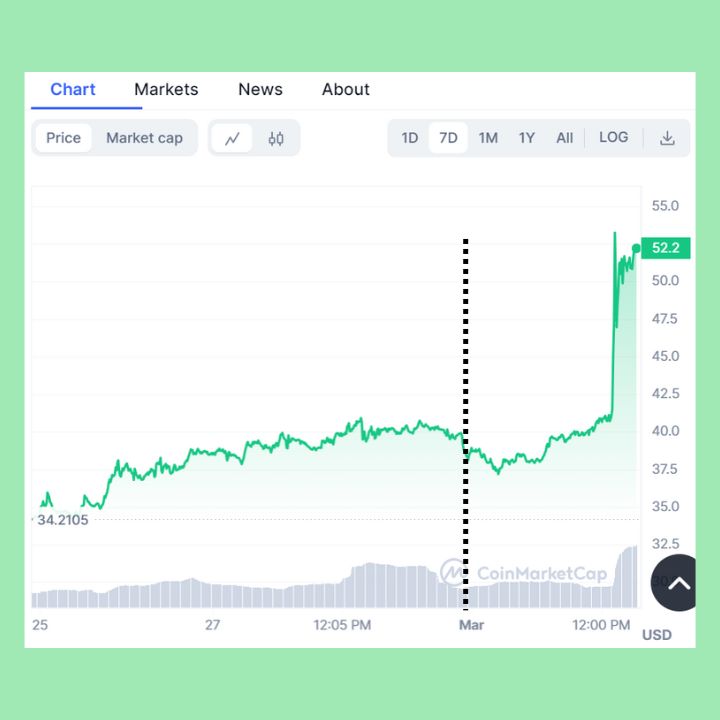In a week where the Chia Coin (XCH) started rising in price before a serious spike on Saturday 2nd March, there is also plenty of other news surrounding the Chia Network.

As Chia readers you are well aware how Chia Network stands out in the ever-evolving landscape of blockchain technology, with its groundbreaking initiatives, heralding a new era of innovation and security.
Within this new forefront is the Chia Academy, a comprehensive educational endeavor designed to empower enthusiasts and developers with deep insights into Chia’s unique blockchain technology. This initiative marks a significant milestone in Chia’s journey, emphasizing education as the cornerstone of blockchain adoption and expertise.
Complementing this educational leap are Chia’s strategic moves to fortify its ecosystem’s security through the transition of its Bug Bounty Program to HackerOne, a decision reflecting their unwavering commitment to safeguarding the network against emerging threats.
Furthermore, the opening of applications for Chia Bridge Validators underscores the network’s dedication to expanding its blockchain’s interoperability and efficiency. Together, these developments encapsulate Chia Network’s holistic approach to fostering a secure, knowledgeable, and interconnected blockchain community, setting the stage for unparalleled growth and innovation. Join us as we delve into these exciting updates and explore what they mean for the future of blockchain technology.

Chia Academy March 2024 Update
Chia released this update article on March 1st, 2024.
“We released Chia Academy in December 2023 to simplify your entry into the world of the Chia blockchain. We’d like to provide some background on why we think providing education matters and what the Chia Academy can do for you!
Why Create the Chia Academy?
“Blockchain education (beyond guides for Solidity) is lacking. We want to provide new developers with a solid foundation of knowledge and skills to build the next generation of blockchain technologies. Chia Academy bridges the gap between curiosity and proficiency – serving both newcomers seeking a solid understanding of blockchain basics and grizzled veteran developers looking to delve into Chialisp intricacies.
Your Learning Journey
“The Chia Academy courses offer a range of content including videos, written guides, and interactive quizzes.
“The initial release features three foundational courses:
- Blockchain Basics: Start your blockchain journey with a solid foundation. This course covers the fundamental concepts and principles that underpin the entire blockchain.
- Building with Chialisp: Deep-dive into Chialisp, gaining a functional understanding of its use and applications within the blockchain ecosystem.
- Plotting & Farming on Chia: Learn more about the processes that keep the Chia blockchain running and secure.
“We hope our efforts encourage exploration, learning, and new opportunities for you. We’re thrilled to have you join us on this journey!”
HackerOne Replaces BugCrowd for the Bug Bounty Program
On February 29th, Chia released this update on the transition to HackerOne from BugCrowd for their Bug Bounty Program as they strive to protect the network from ever evolving risks

“We’re transitioning our bug bounty program from Bugcrowd to HackerOne, a leading bug bounty platform, effective today. This change will allow us to:
- Expand our reach: Connect with a broader pool of talented security researchers worldwide, increasing the probability of discovering potential vulnerabilities.
- Streamline the process: Make reporting and tracking more accessible for researchers with HackerOne’s user-friendly interface and efficient workflow.
- Enhance collaboration: Lead to faster resolution of vulnerabilities through better communication and collaboration between our security team and researchers.
“All information on our bug bounty program can be found on our HackerOne profile.
“Q&A:
“What is changing?
“The main change is the platform we use to manage our bug bounty program. To participate in the program and submit your reports, you’ll need to create a new account on HackerOne.
“Why are we making this change?
“We believe HackerOne offers several advantages that will ultimately lead to a more effective bug bounty program. The platform boasts a wider reach, streamlined processes, and improved collaboration capabilities.
“How will this affect you, if at all?
“If you’re already a participant in our bug bounty program on Bugcrowd, you won’t be able to submit new reports after 3 pm CST (9 pm UTC) on Thursday, February 29, 2024. However, we will transfer all existing reports submitted on Bugcrowd to HackerOne and handle them accordingly. We encourage you to create a new account on HackerOne to continue participating in the program and explore the new platform. We’ll be providing additional resources and support during the transition period to ensure a smooth experience for everyone involved.
“We’re confident that this move will strengthen our security posture and further our commitment to building a secure environment for everyone. We appreciate your continued support and participation in our bug bounty program!”
Chia Bridge and Validator Selection Invitations

On February 28th, this exciting announcement was made, by yakuhito, on the differences between other blockchain bridges and the Cha Bridge, including the invitation for validators to get involved.
“Hello, everyone! I’m yakuhito, and I’m super excited to be delivering the latest update on the upcoming Chia bridge.
“During Chia In China’s Chia Dragon 2024 AMA, Gene revealed that I had been working on a Chia bridge. I have been developing the bridge since earlier this year, with the help of amazing people such as Acevail and the support of the Chia Network Inc. (CNI) team. I’m really proud of the result so far! As the lead validator, my primary job is to ensure that everything runs smoothly, both before and after launch.
Background
“In crypto, bridges are usually used to “transfer” tokens from one blockchain to another. I’m using quotes because it’s not really a transfer – in reality, tokens get locked in a contract on the source blockchain, and equivalent (wrapped) tokens are created on the destination blockchain. You get the original tokens by ‘bridging’ them back – burning the wrapped tokens to retrieve previously locked ones on the other blockchain.
“This, however, introduces a problem: currently, blockchains don’t communicate with each other. You need a trusted party to relay deposits and withdrawals. This is the way bridges work today, and it means that, aside from trusting the contracts, you’re also relying on trusted parties to be online (so they attest transactions) while keeping their keys secure.
“This brings us to the Chia bridge. In its current state, it can connect the Chia blockchain with chosen EVM-compatible blockchains, with the possibility of expanding it to new networks later. Because of operational and technical considerations, what I refer to as the ‘bridge’ can’t just be a multisig – it’s actually made up of two components.
“First, there’s what we call the portal. It connects blockchains by enabling puzzles and contracts to send messages to one another. It relies on a set of validators that pick up messages and attest that they’re authentic. The portal enables any application to send data from one supported blockchain to another. This part allows any application to become multi-chain by adding the portal as a trusted oracle for cross-chain messages.
“Then, there’s the bridge. It’s a set of contracts and puzzles that use the portal to allow users to wrap (and unwrap) Ethereum tokens on the Chia blockchain. The code is non-upgradeable and immutable. It’s one application that can run on top of the portal.
“The code for the bridge can be found here – it’s open-source under the MIT License. While still under heavy development, the frontend code is also available here. I’m very excited about the frontend code, as it builds the transactions required for bridging (which are quite complex) entirely in the browser.
Validator Selection
“Over the past week, I’ve successfully transferred tokens from Sepolia, one of Ethereum’s testnets, to Chia’s testnet11. The bridge is officially in the last development phase when many things will happen in parallel. First, contracts and puzzles will be audited – security should always be a priority in the blockchain world. Second, we’ll work on the frontend to make sure your experience is as good as it can get. Third, validators for the protocol will be selected.
“Validators are an essential part of any bridging/cross-chain messaging protocol. Users rely on them to certify the correct messages, as well as keep an impeccable security posture. We’re taking the selection process extremely seriously.
“More details about what validators are expected to do and instructions on how to apply can be found in this document. Registrations open today and close on Friday, March 8th, at 9:00 am CET.
“The whole validator selection process is controlled by a selection committee formed by yakuhito (that’s me!), Acevail from MintGarden.io, and dns from dexie.space, with recommendations from CNI. To apply, candidates first have to complete a form. We’ll use the responses to select finalists who will be given a short interview. After that, the selection committee will choose the final set of validators for the bridge. CNI will not serve as a validator at this time.
“Well, that’s it! To recap, the main bridge repository is now public. People wanting to become validators must complete the form in this document by Friday, March 8th, 9:00 am CET (8:00 AM UTC). Now that the cat is out of the bag feel free to reach out to me on Twitter with questions and ideas about the Chia Bridge!
— yakuhito, over.”
Disclaimer
The information provided on this page does not constitute investment advice, financial advice, trading advice, or any other sort of advice and it should not be treated as such.
This content is the opinion of a third party and this site does not recommend that any specific cryptocurrency should be bought, sold, or held, or that any crypto investment should be made.
The Crypto market is high-risk, with high-risk and unproven projects. Readers should do their own research and consult a professional financial advisor before making any investment decisions.
